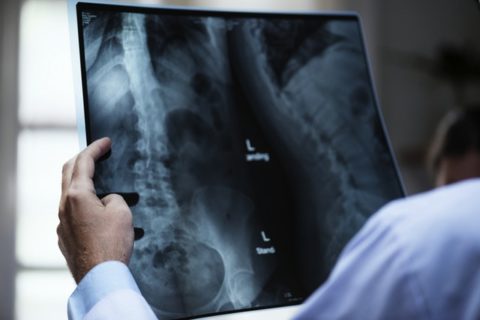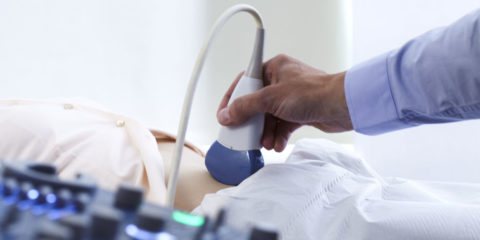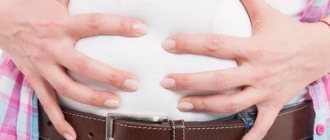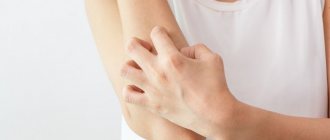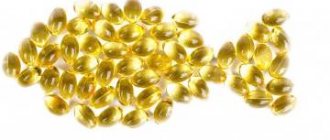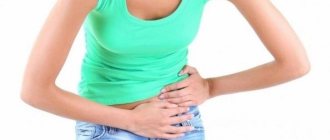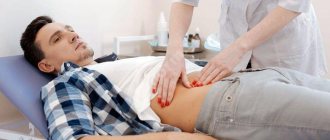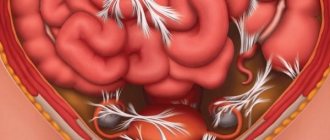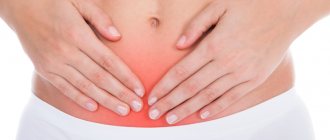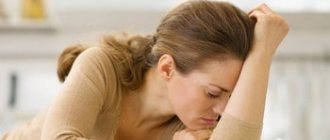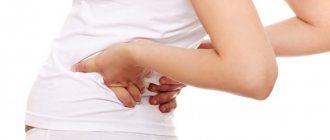03/25/2020 296 Back
Author:ProSpinu
When the right side hurts from the back, the left, then it is no longer possible to be so active and active. Pain takes away strength and energy, and there are many reasons for its occurrence. These can be either various diseases or back injuries. What to do if such signs appear? How to cope with pain and when to see a doctor? About this and much more below.
Possible causes of pain
Sharp pain in any area of the back and lower back makes itself felt. Discomfort, loss of ability to work, awkwardness from the realization of actual powerlessness - all this weighs on us. Therefore, we try to overcome the pain as quickly as possible. All sorts of methods and techniques are used. But is it always possible to “treat” this way, especially without knowing the cause of the discomfort?
Back pain - below, on the right side or left, above or below the lower back - can indicate various diseases. For example, radiculitis, hernia, vertebral displacement. And they all require their adequate treatment under the close supervision of a doctor. Let's look at the causes and symptoms of these ailments and find out what signs are worth going to the doctor for a consultation.
Radiculitis
Radiculitis is usually called an inflammatory process in the root of one of the spinal nerves. The disease appears suddenly. The man got up incorrectly, sat down, picked something up from the floor and it started. Severe pain that permeates the body and does not allow you to move, straighten, or bend.
According to statistics, every eighth resident over forty years of age on our planet suffers from this disease. Today, due to a number of reasons, the disease has begun to affect young people, which, you see, is not very encouraging. The most famous type is lumbosacral. In this case, the lower back suffers. A person with such a diagnosis cannot bend or do anything.
Treatment must be prompt. Although no one considers this illness serious, they say the lumbago and that’s it, it will go away on its own. But if you do not engage in treatment, then attacks of radiculitis will recur more often.
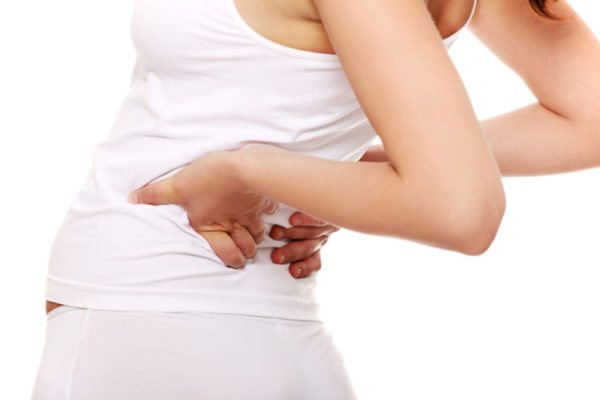
Lumbar hernia
An intervertebral hernia is considered to be a rupture of one of the spinal discs. This happens because a strong load was placed on the lower back and spine, which the body could not bear.
Symptoms of this disease:
- Pain. One side of the lower back feels stiff.
- Discomfort under the ribs when bending or turning.
- Pain that radiates to the buttocks and legs.
- Numbness, burning in the legs.
Vertebral displacement
Displacement of the vertebrae is characterized by a narrowing of the intervertebral canal, which leads to pain and various dysfunctions of organs and systems.
Causes of displacement:
- Spinal injuries. For example, dislocation, fracture.
- Surgical interventions that violated the integrity of the spinal column.
- Accidents, traffic incidents.
- Changes in the spine associated with age.
- Genetic diseases.
- Staying in an incorrect and uncomfortable position for a long time.
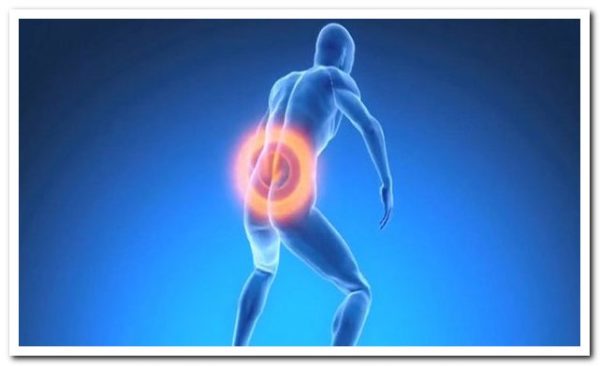
Symptoms of the disease may not appear immediately. Sometimes several years may pass from the moment of displacement until the symptoms appear. But still, the signs often show themselves immediately:
- Disruptions in blood circulation.
- Headache, weakness, fatigue.
- Gastritis, ulcer.
- Pancreatitis.
- Pain on the right or left in the lower back.
Pain on the right
Pain of this kind can be a symptom of various ailments of the internal organs. Of course, it is impossible to make a diagnosis right away. This is done only by a doctor after a detailed diagnosis. As a rule, such a sign signals to us that the liver, intestines, gallbladder or genitourinary system hurts.

The right side of the back often hurts when moving, but if the person is at rest, the discomfort subsides. In this case, you need to go to a doctor for advice and to start treatment, otherwise you can miss the moment and progress the disease to serious and severe stages.
Localization
Back pain can occur in different parts of the back:
- Osteochondrosis, osteoarthrosis, fibromyalgia, ankylosing spondylitis and other pathologies are characterized by discomfort and deterioration of mobility in the shoulder girdle and neck. Left or right, depends on where exactly the nerve root is pinched. Diseases of internal organs and injuries can also cause pain in the back.
- The pain can be localized in the area of the shoulder blades and is expressed in cutting and stabbing sensations. Unpleasant sensations under the right shoulder blade occur as a result of biliary, hepatic colic, cholecystitis and tuberculosis. The area of the left shoulder blade usually frightens the patient more, as he begins to associate the source of pain with the heart, and there are good reasons for this. Often, severe sensations accompany a psychological problem or ulcerative gastritis, as well as inflammation of the pancreas.
- People with ailments of the musculoskeletal system often complain of pain in the central part of the back, between the shoulder blades. A doctor can identify many pathologies, ranging from a herniated disc to spondyloarthritis and intercostal neuralgia. Internal organs should not be discounted either. Lung diseases and hepatitis are frequent companions of interscapular pain.
- The lower back is subject to the greatest stress and is injured more often. Severe pain in this area may occur upon returning from the gym or other physical strain. Such discomfort may go away on its own or indicate ruptures and deformation of the intervertebral discs; inflammation of the joint capsules, sacral radiculitis, arthrosis and osteoporosis, which require immediate treatment. In this situation, pancreatitis, pyelonephritis or the onset of the menstrual cycle may occur.
- Pain below the lower back, in the coccyx area almost never occurs independently, but is combined with pain in adjacent parts of the spine. Such pain can be accompanied by a fracture of the coccyx, scoliosis, hernia, arthrosis, and even inflammation of the appendix or intestinal obstruction.
Women often complain of pain in the lower back during pregnancy, menstruation, and menopause. A visit to the doctor should not be delayed; only he will be able to find the cause of the illness.
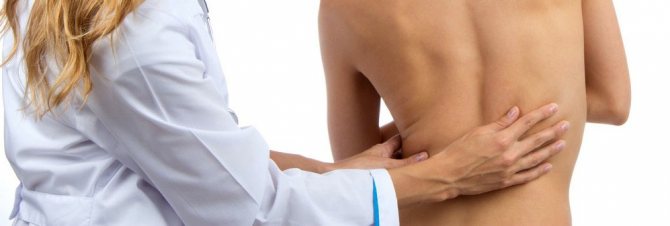
Treatment methods
As a rule, the occurrence of pain in the lower back does not make us happy. In order to prevent the disease from progressing to more severe stages, to prevent it from developing or becoming chronic, it is necessary to begin adequate treatment. Let's look at traditional and non-traditional treatment for lower back pain.
Traditional
As we can see, there are many reasons why back pain occurs, so to begin treatment it is necessary to understand what exactly became the factor in the onset of the disease. For various ailments, the doctor may prescribe painkillers, antibiotics and anti-inflammatory drugs. In addition, physical therapy and massage may be prescribed, of course, if this is possible for a particular ailment.

Non-standard treatments, such as acupuncture or physical therapy, may also be prescribed. In some cases, the effect of these procedures is several times greater than the effectiveness of taking various medications. It is also necessary to follow a special diet. For many diseases it is necessary to avoid:
- Fatty, salty, smoked foods.
- Alcohol and smoking.
- Canned foods.
Also, if necessary, vacuum therapy and ultrasound can be performed.
Folk
If there are no contraindications and you have consulted a doctor, then you can relieve lower back pain with the help of folk recipes for some diseases.
We'll tell you about the most popular and effective ones.
- You can make a compress from grated horseradish or radish for the lower back. To avoid burns, the grated vegetable is mixed with sour cream. Afterwards, wrap the sore spot with a woolen cloth.
- Take one tablespoon of mustard powder and dilute it in warm water so that you get a mixture similar to sour cream in consistency. Apply the mixture to the sore spot and wrap it in something warm. You need to hold it for about five minutes. Afterwards, rinse and apply with rich cream.
- Take the beets, wash them and grate them on a fine grater without removing the peel. Squeeze out the juice and mix the cake with one tablespoon of kerosene. Apply the mixture to natural fabric, preferably cotton, and apply to the sore spot. Cover with a warm scarf on top.
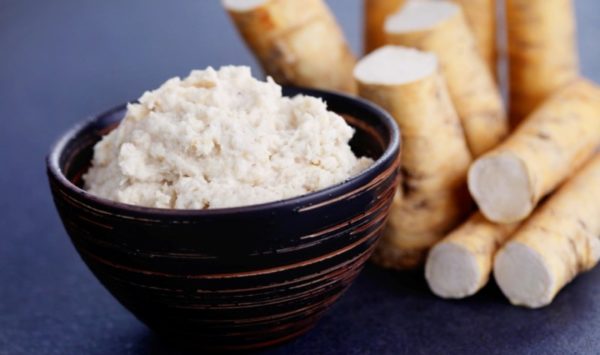
If the kidney hurts on the left side, what other symptoms and treatment could there be?
Painful sensations in women and men indicate dysfunction of many organs, not just the kidney. But in any case, this problem should not be ignored.
In the presence of a concomitant disease, symptoms and treatment when the kidney hurts on the left side differ significantly. Therefore, a thorough diagnosis is necessary so that adequate treatment can be prescribed.
Diagnosis of pathologies
As soon as the left kidney gets sick, you need to immediately identify the cause of the problem.
At the first stage, an examination and history taking by a nephrologist is carried out. The doctor also palpates the kidney to determine the primary signs of its pathology. You will also have to take blood and urine tests to determine the amount of protein and white blood cells in the body.
More precise studies are also being carried out :
- Ultrasound. The method is considered the most informative. Scanning can detect the presence of tumors, inflammation, stones and defects in the structure of the kidney. This study is publicly available and has no contraindications.
- X-ray. Usually performed with contrast agents. The resulting image allows you to determine the size of the kidneys, their shape and possible obstacles to the outflow of urine. It should be noted that with the development of modern methods, X-ray examination is rarely performed.
- MRI. With this diagnostic method, the kidney can be viewed in different planes. The method is absolutely safe, since there is no ionizing radiation.
- Urography. A contrast agent is injected, which “illuminates” the structure of the kidney when it is removed from the body.
The above procedures are considered mandatory, but if necessary, the doctor may prescribe additional tests.
What to do - therapy for kidney diseases
It is advisable to treat the patient in a hospital setting . The treatment regimen depends on the diagnosis. Before seeking medical help, you should adhere to certain recommendations:
- Avoid physical overload and lift heavy objects.
- Avoid hypothermia.
- You need to drink at least 1 liter of water.
- It is necessary to reconsider the diet, excluding spicy, salty and smoked foods.
- Self-administration of medications is prohibited.
Cyst
If the formation is small, then it is usually not touched, preferring only observation . But as the size of the cyst increases, when it begins to compress the surrounding tissues, it must be removed.
Laparoscopy is usually used, that is, it is removed through punctures. But if a cyst is suspected of degenerating into a malignant formation, abdominal surgery is necessary. If the assumption is confirmed, the entire kidney is removed.
Kidney cancer
The best treatment option in this situation, naturally, is removal of the tumor . But it is pre-assigned:
- Chemotherapy.
- Hormonal therapy.
- Radiation therapy.
- Immune therapy.
- Gene therapy.
These techniques can prevent the growth of malignant tumors.
Regardless of the cause of pain on the left, help should only be provided by professionals.
Timely diagnostic measures will ensure correct therapy , which guarantees a healthy and fulfilling life.
To avoid relapse, one should not forget about preventive measures. Following simple rules will prevent recurrence of the unpleasant phenomenon and will allow you to maintain health for many years.
Find out the most common diseases associated with kidney pain from the video:
Why does pain occur in the left kidney?
Very often, when a person experiences unpleasant symptoms in the left side of the lower back, he says that the left kidney hurts. And this is true in most cases, because most often pain in this area occurs due to renal pathologies. Symptoms may also appear for the following reasons:
- for diseases of the spine;
- as a result of injuries.
Human kidneys perform important functions: they participate in metabolism, remove waste and toxins from the body, and maintain a constant content of nutrients (glucose, calcium, phosphorus) in the blood.
Based on some additional symptoms accompanying pain in the left kidney, a preliminary diagnosis can be made.
Table: pathologies causing painful symptoms in the left kidney and associated symptoms
Kidney diseases are easy to distinguish from spinal pathologies. With kidney disease, the patient always has symptoms of intoxication. With diseases of the spine, such signs are not observed.
Photo gallery: diseases that cause pain in the left kidney
With pyelonephritis, an inflammatory process occurs in the kidney, and purulent foci can also form. With kidney cancer, tumors of a malignant nature form in the organ. A kidney cyst is a round formation, inside of which there is a fluid of various composition. Renal colic occurs when a stone gets stuck in the ureter. With glomerulonephritis, the renal glomeruli are affected. scoliosis, the spinal column deviates laterally from the vertical axis
Prerequisites for the appearance of pain syndrome in men and women
Women have an increased risk of kidney pathologies. This happens for the following reasons:
- The female urethra is wider and shorter than the male urethra. Therefore, it is easier for pathogenic microbes to enter the kidneys; The female urethra is wider and shorter than the male one
- During pregnancy, the growing uterus can put pressure on the urinary tract, which often leads to stagnation of urine in the kidneys. This can cause bacteria to multiply in the organ and lead to pyelonephritis;
- During pregnancy, excess production of the hormone progesterone occurs, which suppresses the immune system. The likelihood of inflammatory processes in various organs increases. Bacteria and viruses from any affected organ can enter the kidney through the bloodstream.
In representatives of the stronger sex, pain in the left kidney often arises from prostatitis. The disease is characterized by an increase in the parameters of the prostate gland. A large prostate gland can block the urethra and prevent normal urine flow. This can trigger the development of pyelonephritis.
An enlarged prostate gland may interfere with normal urine flow
In both men and women, the risk of developing kidney pathologies increases with poor diet, sedentary lifestyle, alcoholism, and illiterate use of medications.
Diagnostic measures
To determine the correct diagnosis, the following laboratory tests may be prescribed:
- general blood analysis. It is carried out to determine the level of red blood cells, leukocytes, hemoglobin in the blood;
- biochemical blood test. Provides information about the functioning of internal organs. Determines indicators such as creatinine, urea, cholesterol, glucose;
- general urine analysis. During the study, the color, transparency, and consistency of urine are assessed; the level of hemoglobin, glucose, protein, ketone bodies is determined;
- urine analysis according to Nechiporenko. Shows how many formed elements are in 1 ml of urine;
- bacteriological analysis of urine. Prescribed for suspected pyelonephritis. Identifies the causative agent of the disease;
- puncture of a cyst or malignant formation. During the procedure, the contents of the tumor are collected using a special needle. Next, the biological material is examined in the laboratory under a microscope.
Instrumental diagnostic methods are also used:
- Ultrasound of the kidneys. Detects malignant and benign formations, kidney stones, purulent foci; allows you to evaluate the parameters of the organ and its important structures (pelvis, renal calyces), the condition of the parenchyma; Ultrasound of the kidneys is a safe and effective diagnostic method
- excretory urography. Necessary for diagnosing the condition of the renal vessels. It is carried out with the intravenous administration of a contrast agent to the patient, which enters the kidney through the bloodstream and enhances the visualization of the arteries on an x-ray;
- computed tomography of the kidney. Clarifies the results of ultrasound examination. The method is based on obtaining layer-by-layer images of the organ, which makes it possible to identify even hidden pathologies;
- X-ray of the spine. It is performed if scoliosis or vertebral displacement is suspected. Helps assess the severity of spinal deformity;
- magnetic resonance imaging of the spine. Performed if X-ray results are insufficient to make an accurate diagnosis.
Laboratory research methods are the basis for diagnosing kidney diseases. To identify spinal pathologies, instrumental research methods are the most informative.
Types of treatment
Pain in the left kidney can be eliminated using the following methods:
- drug therapy;
- physiotherapy;
- dietary nutrition;
- surgical intervention.
Drug therapy
For pain in the left kidney, the following medications may be prescribed:
- antibacterial drugs (Ampicillin, Cefomax). Used for infectious processes in the kidneys. Destroy pathogens;
- antispasmodics (No-shpa, Papaverine). Eliminate muscle spasms of internal organs, reduce pain symptoms. Can be used both for kidney diseases and for pathologies of the spine; No-spa effectively eliminates pain in the left kidney
- analgesics (Analgin, Anapirin). Neutralizes pain syndrome;
- diuretics (Furosemide, Veroshpiron). Used when the excretory capacity of the kidneys decreases to increase diuresis;
- antipyretics (Nurofen, Paracetamol);
- probiotics (Bifidumbacterin, Linex). Prescribed after a course of antibiotics to restore normal intestinal microflora; Linex is a probiotic that normalizes intestinal microflora
- chondroprotectors (Rumalon, Chondroxide). Used for osteochondrosis. Stimulate the regeneration of cartilage and bone tissue;
- sedatives (Eglonil, Gidazepam). Used for depression, which often accompanies osteochondrosis and other spinal diseases;
- anti-inflammatory drugs (Diclofenac, Indomethacin). Used for osteochondrosis, scoliosis, and vertebral displacement. The drugs eliminate stiffness of movement, reduce swelling of tissues and swelling of joints, and reduce pain. Available in the form of ointments and tablets.
Useful physical procedures
For diseases that cause pain in the left kidney, the following physiotherapy procedures can be used:
- Electrophoresis. The method is based on the rapid delivery of the necessary medication under the influence of electric current to the pathological area. Electrophoresis is used for urolithiasis, glomerulonephritis, osteochondrosis, and scoliosis. Antibiotics, diuretics, analgesics, antispasmodics, and vitamin complexes can be used as medications. Thanks to this method of drug administration, the duration of action of the drug is prolonged and the likelihood of side effects is reduced. Contraindications: fever, tuberculosis, cancer, heart failure.
Electrophoresis is an effective way to introduce medications into the body. - Ultraviolet radiation of the lumbar region, which is carried out for osteochondrosis and scoliosis. Ultraviolet irradiation promotes the production of vitamin D in the body, improves metabolism, reduces back pain, and improves the condition of cartilage and bone tissue. The procedure is contraindicated in case of fever, skin damage in the lumbar region, infectious processes in the body, or malignant tumors.
Diet food
Diet plays an important role in the treatment of kidney diseases. A proper diet can normalize the excretory capacity of organs, as well as improve metabolism. For kidney pathologies, follow these recommendations:
- reduce salt intake. This product helps to increase blood pressure and dehydrate the body. In addition, excess salt is a common cause of kidney stones;
- exclude from the menu fatty foods that increase cholesterol levels in the blood and increase the load on the kidneys;
- give up alcohol, which poisons the kidneys with toxins; Alcohol impairs kidney function and contributes to intoxication of the body
- eat often (4–5 times a day) and in small portions. This diet facilitates the functioning of the kidneys and gastrointestinal tract;
- actively include the following components in your diet: fruits rich in vitamins;
- vegetables containing fiber;
- dairy products;
- lean varieties of fish and meat;
- whole grain cereals;
- vegetable soups;
- clean drinking water;
Photo gallery: useful products for kidney pathologies
Green tea enhances the excretory ability of the kidneys For kidney diseases, replace fatty broths with vegetable soups Eating whole grain cereals prevents constipation Vegetables are rich in fiber Rosehip decoction strengthens the immune system and enhances diuresis Fruits contain many vitamins
When is surgery needed?
Surgery for pain in the left kidney is used in the following situations:
- when a kidney stone is located in the ureter. The organ is dissected above the area where the calculus is located. The stone is removed;
- for malignant tumors. Cancerous tumors are removed along with “neighboring” tissues to avoid the spread of the malignant process;
- if cysts are diagnosed that contain blood or pus inside. During the operation, the renal capsule is dissected and the cyst is punctured to evacuate the pathological contents. The remnants of the cyst are removed, drainage is installed in the kidney;
- with kidney carbuncle. The purulent focus is opened, cleared of contents and treated with antiseptics;
- with severe displacement of the lumbar vertebrae. During surgery, the tissue in the area where the vertebrae are displaced is dissected. The vertebrae are given the correct position, which is fixed using various implants.
Treatment result and consequences
The result of treating pain in the left kidney depends on the timeliness of diagnosis: the earlier the disease is identified, the easier it is to cope with it.
For kidney diseases, the most dangerous consequences are:
- kidney abscess, which can develop as a result of pyelonephritis. A cavity forms in the kidney, inside which there is pus. The pathology can only be eliminated through surgery; With a kidney abscess, a cavity filled with pus is formed in the organ
- end-stage chronic renal failure, when the kidney completely stops producing urine. This condition may be a consequence of diseases such as urolithiasis, glomerulonephritis, pyelonephritis.
Advanced stages of osteochondrosis and scoliosis can lead to spinal paralysis. In such a situation, a person cannot care for himself and becomes disabled.
Prevention measures
To prevent pain in the left kidney, follow these simple rules:
- complete the treatment of all inflammatory diseases in the body;
- use medications correctly;
- stop drinking alcoholic beverages;
- eat rationally;
- watch your weight and avoid obesity;
- play sports;
- undergo a preventive medical examination annually;
- Don't get too cold.
If you experience pain in your left kidney, you should immediately consult a doctor. Even minor pain in this area can be a harbinger of dangerous diseases.
- Alena Klimova
What should I do?
What to do if your left kidney hurts?
When the first alarming signs appear, you should visit a urologist or nephrologist as soon as possible. The doctor conducts an examination and then sends you for a comprehensive examination.
Table 7. Basic diagnostic methods.
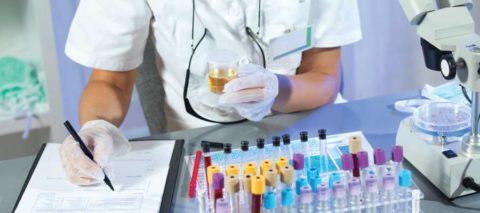
| Diagnostic method | Description |
| Allows you to detect the presence of salts. | |
| General blood analysis | If renal pathology develops, then changes are present in the blood. |
| Allows you to determine the presence of changes in the spine. |
| The study allows you to detect stones. |
General recommendations

Instructions for pain in the kidneys are as follows:
- Avoid strenuous physical activity. It is important to avoid overworking the body. You should not ride a bicycle.
- Wear a bandage. This recommendation is relevant for kidney prolapse.
- Perform physical therapy exercises prescribed by your doctor. The main goal of the exercises is to strengthen the necessary muscles.
- Take medications prescribed by your doctor.
- Avoid hypothermia.
Note! You should not try to treat your kidneys with homemade infusions and decoctions. Uncontrolled use of folk remedies can lead to unpredictable consequences.
Dietary recommendations
The basis of the diet is limited intake of liquid and salt. The cost of non-compliance with this recommendation is quite high - the person has severe edema and blood pressure increases.
The rest of the dietary recommendations look like this:
- The daily salt requirement is 5-6 grams. It is advisable to use sea salt.
- The daily dose of proteins is 30-35 grams.
- It is advisable to replace ordinary water with rosehip decoction. It has a good diuretic effect. Drinking soda and store-bought juices is not recommended.
- Limit the consumption of dried fruits, fermented milk products, and fried vegetables. They contain large amounts of potassium and phosphorus.
- There are more pears and apples.
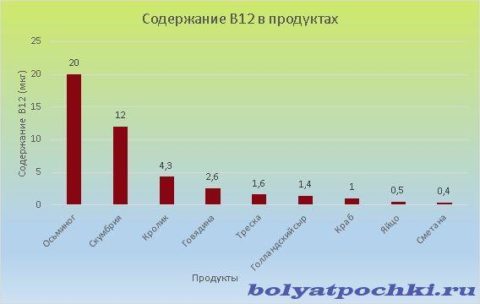
How to treat pain in the left side from the back
Pain in the left side of the back can be eliminated only by treating the underlying disease. All therapeutic measures should be carried out after diagnosis. Self-treatment can only worsen the situation.
To alleviate the patient's condition and relieve pain in the left side during treatment of the underlying disease, non-steroidal anti-inflammatory drugs (Ibuprofen, Diclofenac, Indomethacin, etc.) are prescribed. They are available in the form of injections or tablets. There are also products for external use.
If necessary, muscle relaxants are used to relieve muscle spasms. Such drugs as Mydocalm, Tizalud are widely used. Sometimes external medications are prescribed that have a warming and distracting effect. They are made from bee and snake venom.
When it is confirmed that the pain is associated with dysfunction of the musculoskeletal system, then additionally physiotherapeutic procedures and therapeutic massage can be prescribed for treatment. Yoga is effective because it allows you to recover in the shortest possible time. Acupuncture is also a useful procedure.
If the pain on the left side of the back is acute, which indicates a serious pathology, it is urgent to call an ambulance. Only urgent hospitalization in some cases will help avoid death. In particular, this applies to myocardial infarction.
Many diseases, the symptom of which is acute pain on the left side of the back, require urgent surgery. Otherwise, there may be a threat to life.
It is important to understand that there are no uniform recommendations for the treatment of pain on the left side of the back. At the first stage, the causes of the pain syndrome are always clarified, and then treatment for the underlying disease is prescribed. Only with this approach will it be possible to get rid of pain.
